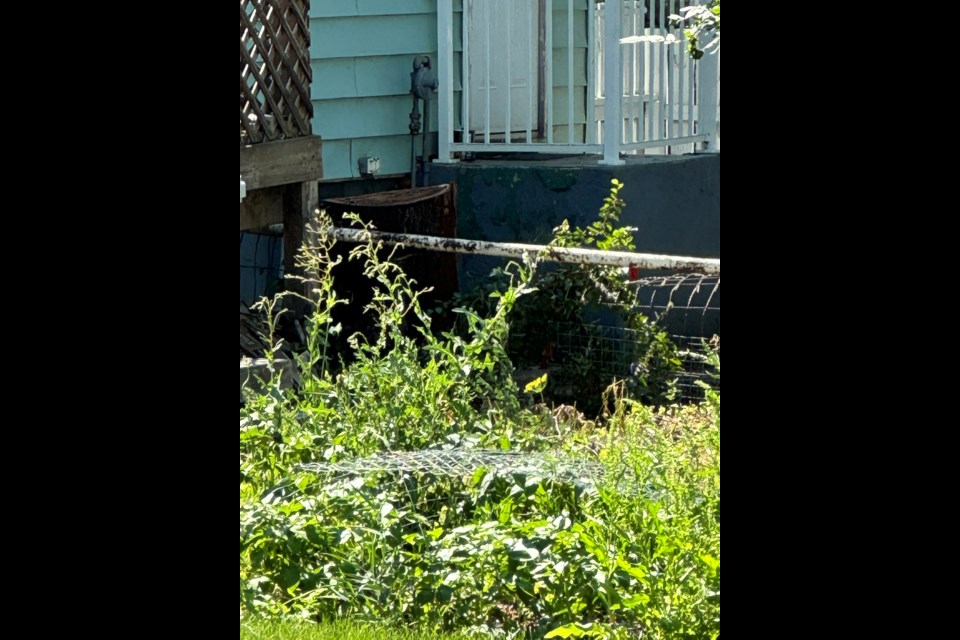MOOSE JAW — Homeowner Tasha Dobni is frustrated with how city hall handled her four calls about a Dutch Elm Disease-infected tree and believes the original contractor — and not city workers — should have removed it.
Dobni called the parks and recreation department on July 19 about an elm tree that a private company was removing two doors away, where she learned that the company had received a removal permit.
However, a day later, she discovered that the company had left the stump, prompting her to call city hall again. She informed an employee that stumps must be removed and ground down during the cutting ban season. The employee, who worked in the cemetery division, allegedly promised to pass along Dobni’s concerns.
Meanwhile, Dobni took pictures of the three-foot-high stump and contacted the Ministry of Environment, which gave her the contact info of city hall officials.
On July 23, Dobni contacted parks director Derek Blais and explained the situation. She learned the municipality only handles elms on city land — like boulevards — and not on private property.
“I question(ed) this, as the City of Moose Jaw issued the permit. So, if you don’t regulate this, then who does?” she said, noting she could hypothetically eliminate an elm from her backyard at any time.
Furthermore, Dobni thought the original contractor was responsible for fully removing the tree. Another concern she shared was that this company was likely performing similar work elsewhere, but there was no follow-up or potential consequences.
Blais said he would review the situation, including potentially fining the company under legislation. Dobni said she left her number so he could call her with an update.
MooseJawToday.com was unable to reach Blais for comment by press time.
Several days passed, prompting Dobni to call Blais on July 26 to ask whether the city would address the stump. His receptionist answered and said the company had allegedly resolved the issue by removing the stump’s bark and pouring a diesel fuel mixture/24D ester on it.
The homeowner checked the yard and found that the company had neither removed the stump’s bark nor the stump. She contacted another tree company, which called city hall to determine what was happening. This time, Blais’ receptionist allegedly said that city staff would remove the stump.
Two city workers arrived at 4 p.m. and, three hours later, had the stump eliminated.
Dobni pointed out that taxpayers paid for the stump’s removal — a $500 cost — since city crews were required, even though the first tree removal company should have done it. Meanwhile, she wondered how many phone calls one citizen had to make to city hall before anything was resolved.
“I raised my concerns as I have two large, healthy elm trees in my backyard. Therefore, I want nothing more than to preserve their health and the rest of the neighbouring elms … ,” she said. “I felt the City of Moose Jaw has no care or concern or knowledge of regulating any bylaws or enforcing them. In addition, they should (be) regulating their permits and tree companies.”
Dobni thought that when issuing a permit, city hall should demand photographic evidence of a project’s completion.
City’s response
City hall told MooseJawToday.com by email that all tree service companies must abide by provincial Dutch Elm Disease regulations, including using chemical treatments to kill stumps.
Meanwhile, the city typically removes stumps on city property using in-house resources and only contracts out removals when crews or equipment are unavailable.
“We can say that when our parks and recreation department (is) made aware of a tree with Dutch Elm Disease, (the) normal procedure is to remove the tree/stump in a timely fashion, so no chemical mix is typically required,” the email said.
After receiving Dutch elm wood permits from city hall, contractors must remove the tree and dispose of it in the landfill and then remove or treat the stump within a “reasonable timeframe,” the email continued.
If the city becomes aware that the company did not comply with the legislation, it will give specific directions about what is required to comply.
“If proper procedures or timelines are not followed and our municipal inspectors feel there is a threat to our urban forest, we are sometimes forced to step in and complete the work ourselves,” the email said.
The city added that there have been 46 known cases of Dutch Elm Disease this year, and if residents have concerns about possibly infected trees, they should contact the parks and rec department.




